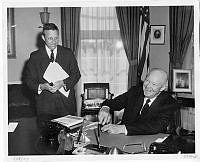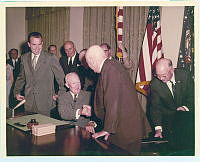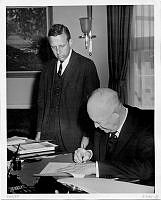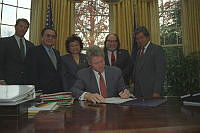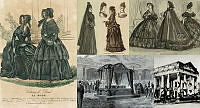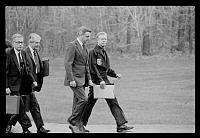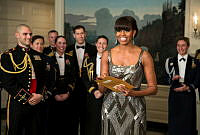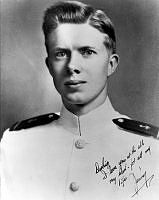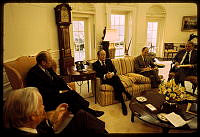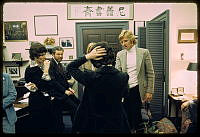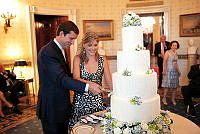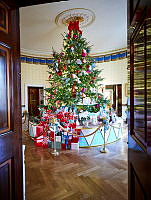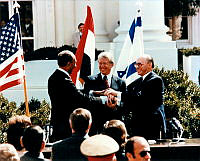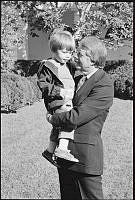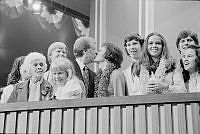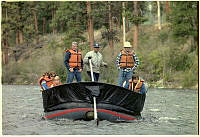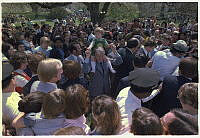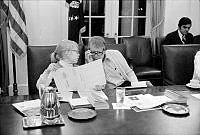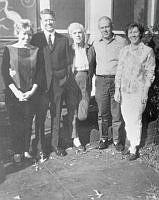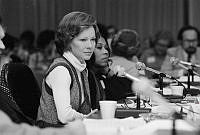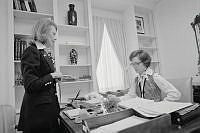Rubenstein Center Scholarship
The Carters at Camp David
When considering Jimmy Carter’s presidential legacy, many historians, scholars, and foreign policy experts often cite the Camp David Accords. President Carter used Camp David as a backdrop during thirteen days of negotiation between Israeli and Egyptian leaders, before signing the accords at the White House on September 17, 1978. Although Camp David played a critical role in one of Carter’s major achievements, the fate of the secluded presidential retreat in Maryland’s Catoctin Mountains remained unclear when his term began. Throughout his presidency, Jimmy Carter came to appreciate the benefits of Camp David, for recreational, family, and diplomatic purposes.
During his 1976 presidential run, Jimmy Carter campaigned on austerity measures to reduce government spending. Shortly after his Inauguration, President Carter began making cuts, including selling off the presidential yacht, Sequoia. He also considered selling Camp David, but some, including former President Richard Nixon, urged Carter not to decide about the retreat until he experienced it.1
President Carter took Nixon’s advice. On February 25, 1977, he asked Office of Management and Budget (OMB) Director Bert Lance to investigate Camp David and halt construction for any future Camp David projects.2 That evening, President Carter, First Lady Rosalynn Carter, and First Daughter Amy Carter headed to Camp David aboard Marine One for a quiet weekend.
But the weekend turned out to be more exciting than quiet. Before arriving at Camp David, Marine One stopped off at the National Naval Medical Center in Bethesda, Maryland. At the hospital, President Carter visited his son, Chip, and daughter-in-law, Caron, who were about to welcome a new baby. Then, Rosalynn, Jimmy, and Amy continued onto Camp David.3
They did not have much time to explore. After landing at Camp David’s helipad around 6:00 p.m., the first family returned to the hospital around 8:45 p.m. to meet James Carter IV, named after his grandfather. President Carter later told the press: “They’re very happy. Chip got through it okay. She’s just fine. The baby looks well-developed. He looks like Caron, thank goodness.”4 After meeting their grandson and congratulating the proud parents, the Carters returned to Camp David. Before returning to Washington, they also attended a nearby church service.5
Over the next few months, President Carter continued to visit Camp David and began to enjoy the rustic retreat. On Carter’s second visit in late March, he was joined by his family, including his now four-week-old grandson, James. The president and first lady took a bike ride around the property and President Carter enjoyed a swim with Amy in the heated pool. President Carter also expressed to journalists that he enjoyed the privacy and limited media coverage at the retreat, stating, “We need to keep it that way.”6

President Jimmy Carter and First Lady Rosalynn Carter ride bikes at Camp David.
Jimmy Carter Presidential Library & Museum/NARAFinally, after several additional visits, a positive report from OMB Director Bert Lance, and an extended stay in early August 1977, President Carter decided not sell Camp David. Ultimately, for the busy president, it offered an opportunity for privacy and relief from the hustle and bustle of the White House. Carter enjoyed a more laid-back schedule while at Camp David. His appointments secretary, Tim Kraft, stated: “There is no set routine. There’s no schedule, which is the way he likes it.7
Soon, President Carter began to see the potential for the retreat to serve as more than a secluded backdrop for family fun. He saw it as an opportunity for diplomacy. In fact, Camp David already had a long history of diplomacy. President Franklin D. Roosevelt hosted British Prime Minister Winston Churchill at the camp (then called Shangri-La) in 1943, while President Dwight D. Eisenhower hosted Soviet Premier Nikita Khrushchev in 1959, the first visit by a Soviet leader to the United States.8
As President Carter turned his focus to tensions in the Middle East, he invited Egyptian President Anwar Sadat to Camp David in February 1978, following Sadat’s groundbreaking trip to Jerusalem in November 1977.9 The main advantage of Camp David as a location for this meeting was privacy. Newspapers lamented, “Privacy is Camp David’s keystone” and provided very few details of the meeting. Instead, the press had to rely on telephone press briefings from White House Press Secretary Jody Powell while photographers were only briefly allowed to enter the grounds for photographs.10

President Jimmy Carter sleds with First Daughter Amy Carter and her friend, Ada Gastayer during Sadat’s February 28, 1978 visit.
Jimmy Carter Presidential Library & Museum/NARADespite his February meeting with Sadat, tensions in the Middle East rose throughout the summer of 1978. Although outcomes looked bleak, Carter hoped to avoid stalemate and make progress toward peace by brokering discussions with key leaders. In July, while walking with Rosalynn at Camp David, he told her:
It’s so beautiful here. I don’t believe anybody could stay in this place, close to nature, peaceful and isolated from the world, and still carry a grudge. I believe if I could get Sadat and Begin both here together, we could still work out some of the problems between them, or at least we could learn to understand each other better and maybe make some progress.11
In early August, President Carter dispatched Secretary of State Cy Vance to deliver invitations to Egyptian President Anwar Sadat and Israeli Prime Minister Menachem Begin.12 Both leaders accepted and preparations for a summit at Camp David began. The summit operated similarly to Sadat’s February visit; media were not allowed on site and received their information directly from Jody Powell. This insulated Begin and Sadat from outside voices and kept the talks under wraps without media influence. Despite the careful preparations, the summit still got off to a rocky start.

In this photograph, President Jimmy Carter and First Lady Rosalynn Carter walk the grounds of Camp David with Prime Minister Menachem Begin of Israel and his wife Aliza Begin.
Jimmy Carter Presidential Library and Museum/NARAWhile Carter considered Camp David a beautiful and peaceful space that could facilitate dialogue, the visiting delegations were not impressed. According to Israeli Defense Minister Ezer Weizman, “The tall trees make the light gloomy, and one has to lift one’s eyes to find a patch of blue sky.”13 In addition, the initial meeting between Begin and Sadat went poorly on September 5, 1978. According to Rosalynn, “Jimmy felt that the whole plan was probably futile. Instead of looking to the future, Begin remained entrenched in the past…”14

Prime Minister Menachem Begin plays chess at Camp David with National Security Advisor Zbigniew Brzezinski.
Jimmy Carter Presidential Library & Museum/NARADespite the ongoing tensions, President Carter utilized the summit’s location to its fullest. Sadat walked Camp David’s trails in the mornings, while Begin played chess with National Security Advisor Zbigniew Brzezinski.15 People shuttled between the various cabins on the property and continued efforts were made to have the delegations interact. On one evening, the Marine Corps Silent Drill Team performed, and the press was allowed into Camp David for the occasion. Several days into the summit, President Carter organized an outing to the Civil War battlefield in nearby Gettysburg, Pennsylvania, which both Begin and Sadat attended.16

Begin and Sadat shake hands at Camp David.
Tensions remained high as the summit continued with talks coming to a stalemate several times and threats to leave early. Eventually, after much back and forth, mediation by Carter and his aides, and compromise, Begin and Sadat were able to find common ground. Finally, on the thirteenth day, September 17, 1978, they had a framework for a peace agreement. The delegations departed Camp David and made their way to the White House. From the East Room during a televised ceremony that evening, Anwar Sadat and Menachem Begin signed the framework. President Carter stated: “Well, the long days at Camp David are over. But many months of difficult negotiations still lie ahead.” On March 26, 1979, Begin and Sadat returned to the White House to sign the Egyptian-Israeli Peace Treaty.17

Carter, Sadat, and Begin sign the Camp David Accords in the White House East Room on September 17, 1978.
Jimmy Carter Presidential Library & Museum/NARAWith the summit behind him, President Carter returned to Camp David numerous times throughout the remainder of his presidency. Primarily, he continued to use it as a place to relax, seek solitude, and spend quality time with his family. He enjoyed the outdoor recreational opportunities at Camp David, riding bikes, exploring trails, and cross-country skiing, although sometimes these activities got him into trouble. In December 1980, shortly before the end of his presidency, President Carter fell while cross-country skiing and broke his collarbone. He helicoptered to Bethesda Naval Medical Center for treatment before returning.18 Jimmy and Rosalynn also frequented a nearby trout fishing stream called Hunting Creek. In the evenings they often watched movies at Aspen Lodge, the presidential quarters.19
The Carters also participated in local events, frequently attending church services in nearby Thurmont. On one occasion in September 1979, President Carter, an avid jogger, entered the 6.2-mile Catoctin Mountain Race. Despite his efforts, he dropped out of the race in mile four on the advice of White House Physician William Lukash, later saying, “They had to drag me off. I didn’t want to stop.”20
In addition to recreation and family bonding, Camp David remained a location where Carter went to contemplate difficult decisions facing his presidency and make advancements on other international issues. For example, in November 1979, President Carter met with Secretary of Defense Harold Brown, Secretary of State Cy Vance, and Vice President Walter Mondale to discuss the unfolding Iran Hostage Crisis. It once again served as a secluded location for discussions without media reports and influence.21

This photograph captures President Jimmy Carter arriving at Camp David in Catoctin Mountain Park, Maryland on November 23, 1979. Accompanying President Carter on the helicopter trip from the White House to Camp David was, from left to right, Secretary of Defense Harold Brown, Secretary of State Cyrus R. Vance, and Vice President Walter F. Mondale. The group was on hand to meet and discuss the Iran Hostage Crisis, which began earlier that month, on November 4. The hostages would be held for 444 days, until January 20, 1981.
Library of CongressWhen Jimmy Carter left the White House in January 1981, the property that he initially considered closing had become central to his presidency and legacy. Over four years, President Carter visited Camp David nearly 100 times, ultimately spending more than ¾ of a year there. For Carter, it was a site of diplomacy, recreation, family fun, and peace.22














